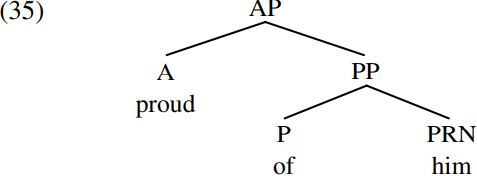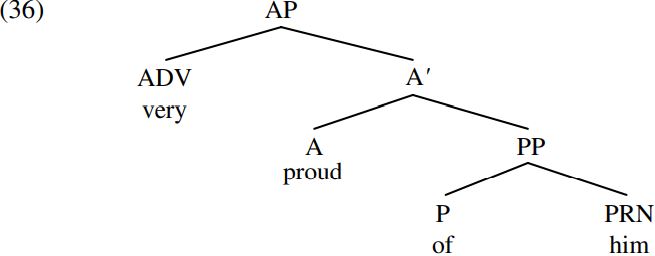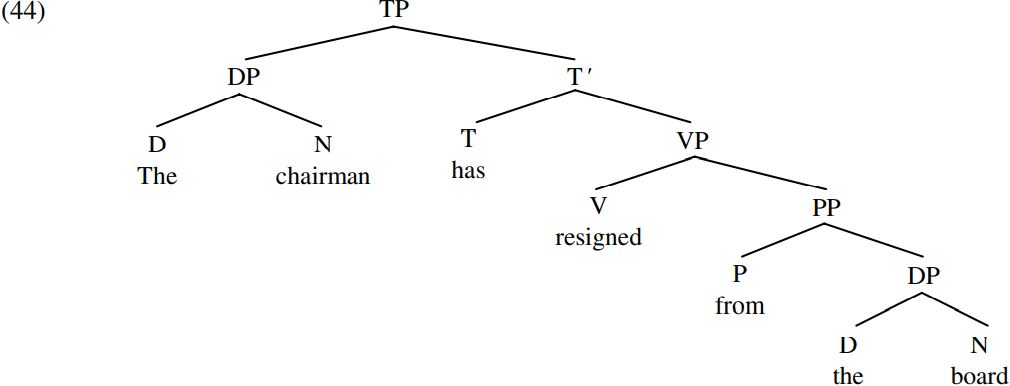


 Grammar
Grammar
 Tenses
Tenses
 Present
Present
 Past
Past
 Future
Future
 Parts Of Speech
Parts Of Speech
 Nouns
Nouns
 Verbs
Verbs
 Adverbs
Adverbs
 Adjectives
Adjectives
 Pronouns
Pronouns
 Pre Position
Pre Position
 Preposition by function
Preposition by function 
 Preposition by construction
Preposition by construction
 Conjunctions
Conjunctions
 Interjections
Interjections
 Grammar Rules
Grammar Rules
 Linguistics
Linguistics
 Semantics
Semantics
 Pragmatics
Pragmatics
 Reading Comprehension
Reading Comprehension|
Read More
Date: 2023-11-14
Date: 2023-08-29
Date: 2023-10-30
|
One aspect of our analysis of prepositional phrases which might at first sight seem puzzling is that the same expression on the nose is analyzed as a PP in (23Bi/25), but as a P-bar in (23Bii/28). Why should this be? The answer is that the label PP denotes the maximal projection of (i.e. the largest expression headed by) the relevant preposition in a given structure. In (23Bi), speaker B replies On the nose: since the largest expression headed by on in (23Bi) is On the nose, it follows that On the nose has the status of a PP here. By contrast, in (23Bii) speaker B replies Right on the nose: here, on the nose is not the largest expression headed by on, and hence is not a PP but rather a P-bar; on the contrary, the largest expression headed by on in (23Bii) is Right on the nose, so it is this larger expression which has the status of PP.
Interestingly, there is some empirical evidence in support of the claim that on the nose is not a PP in (23Bii/28). As we see from examples like (32) below, a PP (like that italicized below) can generally be preposed/fronted (i.e. moved to the front of the sentence) in order to highlight it:

In the light of this observation, consider the following examples (where right in each case is to be interpreted as a modifier of on the nose):

The fact that right on the nose can be preposed in (33b) but not on the nose in (33c) provides evidence in support of the claim in (28) that right on the nose is a PP in (33a) but on the nose is not. If we assume that only maximal projections can be preposed, it follows that right on the nose can be preposed in (33) because it is the maximal projection of the preposition on (hence a PP), whereas on the nose cannot because it is an intermediate projection of the preposition on (hence a P-bar).
Although we have pointed out similarities between the structure of a PP like that in (28) and the structure of a TP like that in (17), there is a very important difference between the two. As we saw earlier from the grammaticality of We are trying to help you and the ungrammaticality of ∗Are trying to help you as replies to the question What are you doing?, tense auxiliaries like are obligatorily require an appropriate specifier (e.g. a subject pronoun like we). By contrast, the fact that we can reply either On the nose or Right on the nose to a question like Where did she hit him? tells us that prepositions can be used either with or without an appropriate kind of specifier (e.g. an adverbial modifier like right). So, a significant difference between auxiliaries and prepositions is that it is obligatory for an auxiliary to have a specifier but optional for a preposition to have a specifier.
Just as prepositional phrases can have an (optional) adverbial modifier as their specifier, so too can adjectival phrases – as we see from the alternative replies given by speaker B in (34) below:
 Reply (i) Proud of him in (34B) is an adjectival phrase/AP derived as follows. The preposition of merges with the pronoun him to form the PP/prepositional phrase of him. This is then merged with the adjective proud to form the AP/adjectival phrase proud of him, which has the structure (35) below:
Reply (i) Proud of him in (34B) is an adjectival phrase/AP derived as follows. The preposition of merges with the pronoun him to form the PP/prepositional phrase of him. This is then merged with the adjective proud to form the AP/adjectival phrase proud of him, which has the structure (35) below:

But what is the structure of reply (ii) Very proud of him in (34B)? This differs from Proud of him in that it contains the adverb very. It seems implausible that the adverb very could be the head of the overall expression Very proud of him since this would mean that very proud of him was an ADVP (adverbial phrase); but an ADVP analysis would be problematic because a question like How does she feel? can have an adjectival expression like Happy as an appropriate reply but not an adverbial expression like Happily. Since Very proud of him can be used to reply to the how-question asked by speaker A in (34), very proud of him must be an adjectival expression headed by the adjective proud. Using the bar notation introduced earlier, we can say that the A/adjective proud merges with its PP/prepositional phrase complement of him to form the A-bar (intermediate adjectival projection) proud of him, and that the resulting A-bar in turn merges with the adverbial specifier very to form the full AP/adjectival phrase in (36) below:

Evidence in support of the analysis in (36) comes from data relating to the preposing of adjectival expressions in sentences such as (37) below

If we assume (as we did in our earlier discussion of (33) above) that only maximal projections can be preposed in this way (not intermediate projections), we can provide a straightforward account of the data in (37) in terms of the analysis in (36). The structure in (36) tells us that very proud of him is the maximal projection of the adjective proud, and so is an AP/adjectival phrase constituent; hence it can be preposed in (37a) by virtue of its status as a maximal projection. By contrast, (36) tells us that proud of him is an intermediate projection of the adjective proud and hence an A-bar constituent: because only maximal projections like AP can be preposed, and because proud of him is only an intermediate A-bar projection, it cannot be preposed – hence the ungrammaticality of (37c).
A variety of other types of expression can also have extended projections via merger with an optional specifier of an appropriate kind. One such are adverbial expressions like those italicized in (38) below:

The adverb independently can be merged with a PP/prepositional phrase complement like of me to form the adverbial expression independently of me: this can serve either as a ADVP/adverbial phrase on its own – as in (38a) – or as an intermediate ADV-bar projection which can be extended into an ADVP by merger with an appropriate specifier (like the adverb quite) as in (38b).
Much the same might be said about the italicized noun phrases in (39) below (if the analysis of these structures in Radford 1993 is along the right lines):

The noun ban can be merged with a following prepositional phrase complement like on imports to form the nominal expression ban on imports: this can either serve as a complete noun phrase/NP on its own, or can serve as an intermediate N-bar projection which is subsequently merged with an appropriate specifier (like the noun government) to form the larger noun phrase/NP government ban on imports. Because a noun expression headed by a singular count noun (like ban) must be modified by a determiner or quantifier, the resulting NP in either case must subsequently be merged with a determiner like the or a quantifier like any, so deriving a DP/determiner phrase like the (government) ban on imports or a QP/quantifier phrase like any (government) ban on imports.
In all of the structures which we have looked at so far which contain a specifier (i.e. in (17), (22), (28), (36), (38b) and (39b) above), the specifier has been a single word. However, this is by no means always the case, as we can see by comparing the two clauses in (40) below:

(40a) is derived by merging the T/tense auxiliary has with its verb complement resigned to form the intermediate T-bar projection has resigned, and then merging the resulting T-bar with the pronoun he which serves as its specifier/subject to derive the extended TP projection in (41) below:

Now consider how we derive (40b) The chairman has resigned. As before, the tense auxiliary has merges with its verb complement resigned to form the T-bar has resigned; and as before, the resulting T-bar then merges with its subject specifier. However, this time the subject is not the single word he but rather a determiner phrase/DP the chairman which has itself been formed by merging the determiner the with the noun chairman. The result of merging the DP the chairman with the T-bar has resigned is to derive the TP (42) below:

Evidence that the chairman is indeed the subject (and specifier) of has in (42) comes from auxiliary inversion facts in relation to sentences such as:

As we see by comparing the statement (40a) He has resigned with the corresponding question (43a) Has he resigned? a question like (43a) is formed by moving a finite auxiliary (has) in front of its subject (he). Hence, the fact that the auxiliary has in (40b) moves in front of the chairman in (43b) Has the chairman resigned? suggests that the chairman is the subject of has in (40b) The chairman has resigned – precisely as is claimed in (42).
If we compare (41) with (42), we can see that a specifier can be either a single word like he in (41) or a phrase like the DP the chairman in (42). In much the same way, a complement can be either a single word or a phrase. For example, in (42), the complement of has is the verb resigned; but in a more complex structure like (44) below:

the complement of has is the verb phrase resigned from the board, which is formed by merging the verb resigned with its PP/prepositional phrase complement from the board.
|
|
|
|
التوتر والسرطان.. علماء يحذرون من "صلة خطيرة"
|
|
|
|
|
|
|
مرآة السيارة: مدى دقة عكسها للصورة الصحيحة
|
|
|
|
|
|
|
نحو شراكة وطنية متكاملة.. الأمين العام للعتبة الحسينية يبحث مع وكيل وزارة الخارجية آفاق التعاون المؤسسي
|
|
|